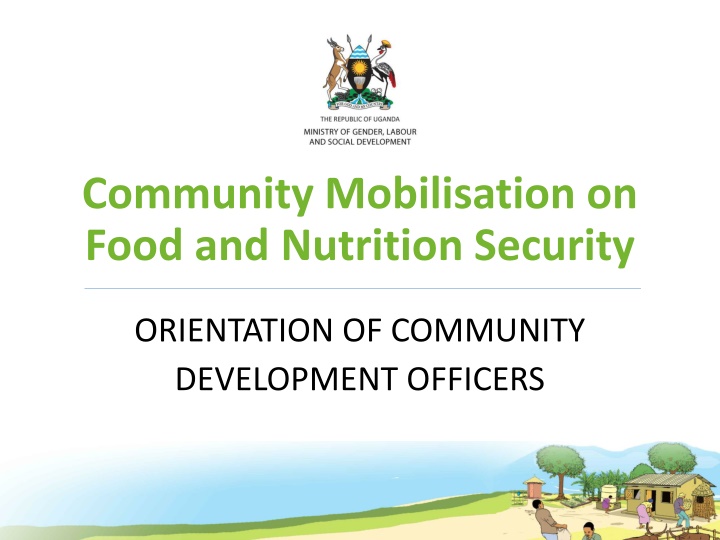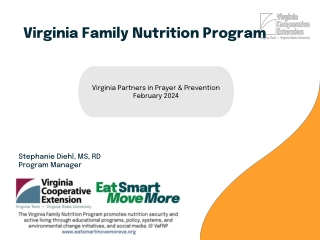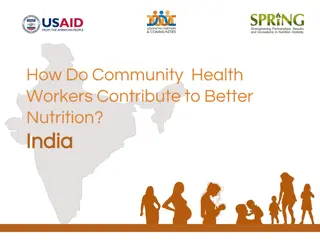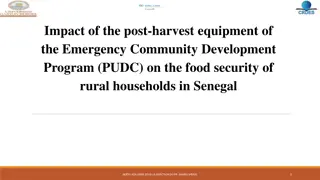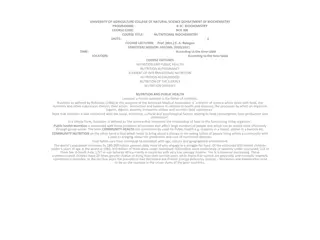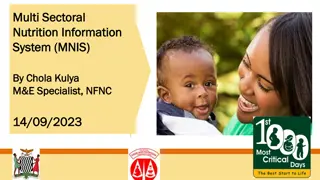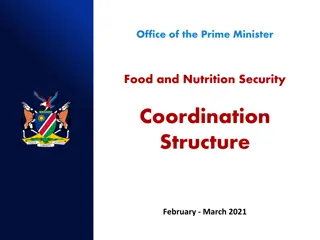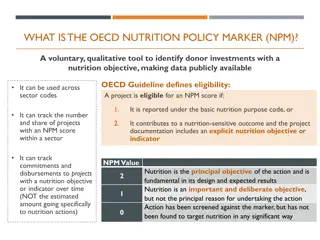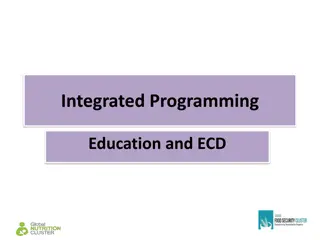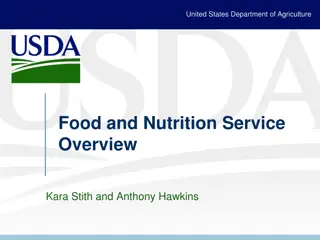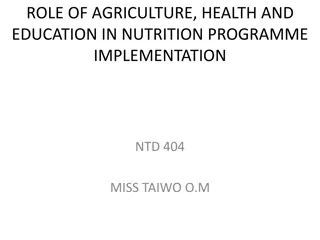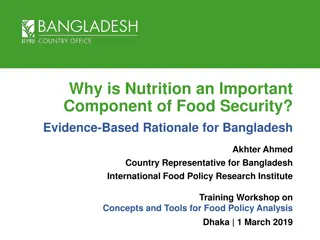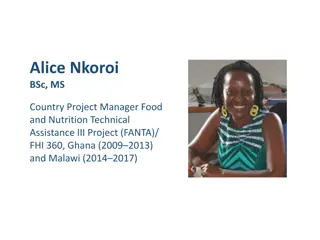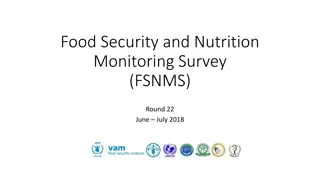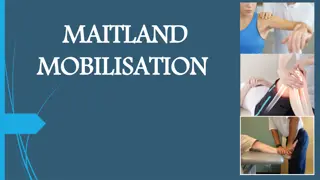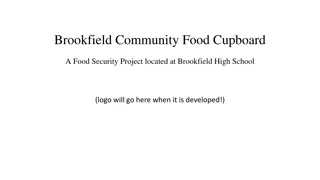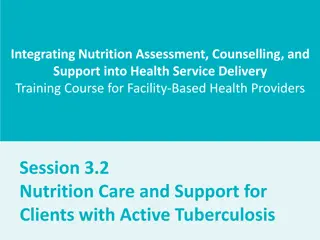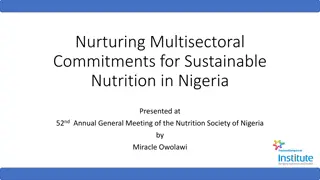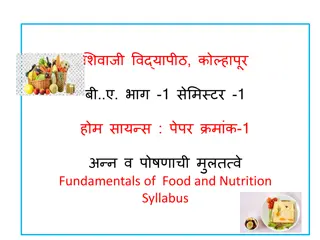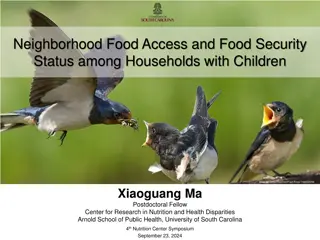Community Mobilisation on Food and Nutrition Security: Orientation Program for Development Officers
This orientation program aims to equip community development officers with the knowledge and skills to mobilize communities for improving food and nutrition security. Participants will learn about planning community mobilization activities, engaging key stakeholders, conducting dialogue meetings, home visits, and making referrals. The program also introduces the Community Mobilisation Package, providing guidance on practical discussions and roles of community members in enhancing food and nutrition security.
Download Presentation

Please find below an Image/Link to download the presentation.
The content on the website is provided AS IS for your information and personal use only. It may not be sold, licensed, or shared on other websites without obtaining consent from the author.If you encounter any issues during the download, it is possible that the publisher has removed the file from their server.
You are allowed to download the files provided on this website for personal or commercial use, subject to the condition that they are used lawfully. All files are the property of their respective owners.
The content on the website is provided AS IS for your information and personal use only. It may not be sold, licensed, or shared on other websites without obtaining consent from the author.
E N D
Presentation Transcript
Community Mobilisation on Food and Nutrition Security ORIENTATION OF COMMUNITY DEVELOPMENT OFFICERS
Session 1: Orientation Introduction
Session 1 objectives By the end of the session, participants will have: Met one another Understood the objectives of the orientation Taken the pre-test 3
Objectives of the orientation To disseminate the content of the community mobilisation package on food and nutrition security To enhance participants knowledge about: Planning community mobilisation for improving food and nutrition security Key stakeholders involved in mobilisation for food and nutrition security and their roles Food security, food insecurity, good nutrition, and malnutrition To enhance participants skills in conducting community dialogue meetings on food and nutrition security To enhance participants knowledge of and skills in conducting home visits and making referrals To enhance participants skills/capacity to conduct orientation on the mobilisation package in their districts 4
Session 2: Introduction to the Community Mobilisation Package
Session 2 objectives By the end of the session, participants will be able to identify: Purpose of the package (guide and flip chart) Users of the package Key terms Principles of community mobilisation 6
Purpose of the package The package is intended to provide community mobilisers with: Guidance on how to plan community mobilisation activities to improve food and nutrition security Descriptions of the various roles of different community members in improving food and nutrition security Examples of practical discussions to have with community groups to explain food and nutrition security, its importance, and ways to improve it Guidance on conducting home visits and making referrals for malnourished children 7
Users of the package This guide is to be used by community resource persons, including: Community development officers/workers Parish Development Committees Functional adult literacy instructors Community-based informal groups Also recommended for other players who interact with various groups of people in the community and can influence their knowledge, attitudes, and practices 8
Key terms Brainstorm definitions of the following terms: What is a community mobiliser? Types of community mobilisers What is food and nutrition security? 9
What is a community mobiliser? An individual who interacts with various groups of people to influence their knowledge, attitudes, and practices and causes them to take action to address an identified problem or problems Such individuals include: Community development officers/workers Parish Development Committee Members Functional adult literacy instructors Group promoters Community-based facilitators Village health team members 10
Food and nutrition security Food and nutrition security refers to when households have enough quality food to eat at all times during the year. Food should be: Enough (quantity) Of good quality Available at all times 11
Principles of community mobilisation Brainstorm on the following principles: Participation Accountability Good governance Access to information 12
Principles of community mobilisation Participation Community members should be part of problem appreciation. Community members should be part of the solution, from planning through implementation to monitoring and evaluation. Different community members (men, women, youth, people with disabilities, older persons, etc.) should be included. Participation promotes ownership. Accountability Emphasis should be on sharing information on any activity taking place and having a strong feedback mechanism. People should be committed to their assigned responsibilities. Individuals should be accountable for showing results from their assignments. 13
Principles of community mobilisation Good governance People should be given an opportunity to participate in decisions and processes that affect them. The mobiliser, gatekeepers, and local leaders should be sure to involve different categories of people, especially those at risk of food insecurity and malnutrition, to ensure early ownership and commitment. Accountability itself (above) is a key ingredient of good governance. Good governance promotes ownership and sustainability. Access to information by all Access to information is a right. Community members should be able to access information on food and nutrition security such as: Procedures for accessing relevant services related to food and nutrition Different levels/centers of responsibility for services Current and expected community interventions 14
Session 3: Planning Community Mobilisation for Improving Food and Nutrition Security
Session 3 objectives By the end of the session, participants will be able to: Describe the phases involved in planning community mobilisation for improving food and nutrition security Determine what and who are involved at each phase 16
Purpose of planning Helps the community mobiliser get a clear understanding of the phases involved in planning for community mobilisation for improving food and nutrition security Specifically, the community mobiliser should be able to determine: The phases involved What is involved at each phase Who is involved at each phase 17
Phases in community mobilisation for food and nutrition security Phase 1: Planning Phase 2: Community entry and awareness of gatekeepers Phase 3: Community mobilisation Phase 4: Taking action together Phase 5: Participatory monitoring and evaluation (assessing outcomes of successful community mobilisation) 18
Phase 1: Planning Determine the food and nutrition security issues to be addressed Discuss the food and nutrition situation with knowledgeable people in the community. Identify and involve the right people Who are the community gatekeepers (the people with power and influence within the community)? Define what needs to be done and how What activities and strategies should be used? What will make community mobilisation for food and nutrition security successful? How will success be measured? 19
Some Food and Nutrition Security Questions for Planning Phase Do households consume a variety of foods from crops and livestock throughout the year? If not, why? How many meals do most households consume each day? Do households have backyard gardens? Are households crops drought-resistant? Do women give their infants only breast milk for the first 6 months (no other food or water)? Do households have access to clean, safe water? What water sources are used? Are household drying racks available for use? Are pit latrines available and used? 20
Gatekeepers to consider for planning phase Who are the right people to involve as gatekeepers? People the community is likely to listen to People with power and influence who can influence others Gatekeepers include: Local political leaders Religious and cultural leaders Parish Development Committee members Initial ideas should be shared with gatekeepers so that they become allies and encourage participation. 21
Phase 2: Community entry and awareness of gatekeepers Identify food and nutrition security issues that are of interest to the community The mobiliser and the gatekeepers should: Agree on community groups (audiences) to invite to the mobilisation meeting Agree on a venue and date Agree on approaches to use Agree on how and who will publicize the meeting (beyond simply issuing a letter) 22
Phase 3: Community mobilisation Implement the agreed-upon approach to mobilise the community. The approach should ensure the community is aware of and understands: Definitions and signs of food security and food insecurity Causes and consequences of food insecurity Definitions and signs of good nutrition and malnutrition Causes and consequences of malnutrition 23
Phase 4: Taking action together Based on an understanding of food security and nutrition as well as food insecurity, malnutrition, and their causes and consequences, the community should agree on actions to address their issues. This translates into an action plan that spells out: Identified problem Agreed-upon tasks Persons to do the tasks Timeframe for accomplishing tasks Signs of successful implementation of tasks 24
Phase 5: Participatory monitoring and evaluation (assessing outcomes of successful community mobilisation) Examples of ways to assess a community mobilisation activity: Community meetings held on food and nutrition security Minutes of community meetings are recorded and shared More households with gardens to increase food security More people seeking food and nutrition security information or services Community groups are established and addressing food and nutrition security issues 25
Session 4: Roles of Stakeholders in Community Mobilisation for Improving Food and Nutrition Security
Session 4 objectives By the end of the session, participants will be able to identify: Key people and/or groups that can help drive the food and nutrition agenda at the community level The roles these people or groups can play 27
Schools (Includes teachers, parent-teacher associations, pupils/students, management committees) Hold classroom discussions on food and nutrition security Organize students to engage in food and nutrition security activities, such as school gardens and learning about healthy food choices Organize demonstrations on improved farming techniques Engage role-model farmers and extension workers to exchange information with students Engage students in outreach activities such as performing cultural/theatrical activities on food and nutrition security 28
Parents/caregivers Grow or buy a sufficient quantity and variety of food for the household Follow guidance for feeding infants and young children and ensure children and dependents are fed enough of various types of food Participate in community dialogue and mobilisation; support the community action plan Attend seminars, meetings, demonstrations, exhibitions, and trainings to gain knowledge, information, and skills pertaining to food and nutrition security Work closely with others to form parent associations on food and nutrition security 29
Parents/caregivers (cont.) Use family planning to have a manageable number of children. Take children for healthy- and sick-child visits as needed to receive all immunizations; participate in any community activities that promote child growth. Use clean and safe water, sanitation, and hygiene practices including: Handwashing with soap/ash: Before preparing food, eating/feeding, After using the toilet or cleaning someone who has defecated Having, using, and maintaining a household latrine Treating drinking water and storing it safely in a covered container 30
Community leaders Encourage household heads and other members to engage in farming that promotes food and nutrition security Identify model farmers to exchange information with other community members Mobilise households to build appropriate food storage facilities Identify households that are at risk of food and nutrition insecurity and sensitize them to get involved in community interventions Link farmers to appropriate extension workers 31
Community leaders (cont.) Follow up on implementation of community food and nutrition security action plans Mobilise schools to teach agriculture and re-introduce school gardening Provide information to couples on manageable family sizes Promote clean, safe water, sanitation, and hygiene practices at the community and household level Follow up on implementation of community food and nutrition security action plans 32
Parish Development Committees Report food and nutrition security issues to relevant authorities so that proper action can be taken (e.g., in the case of natural disasters such as hailstorms, floods, and landslides) Include food and nutrition security objectives and activities in development plans 33
Development Agencies and Civil Society Organizations Disseminate relevant food and nutrition security knowledge and information Advocate for attitudes, beliefs, and practices that promote food and nutrition security Incorporate food and nutrition security issues into programs Connect with extension workers and community mobilisers Provide resources to improve food and nutrition security Follow up with and support families at risk of malnutrition and food insecurity Advocate for local governments to increase resources allocated to food and nutrition security Monitor food and nutrition security interventions in communities and share reports with relevant stakeholders 34
Religious leaders Integrate food and nutrition security messages into sermons Demonstrate appropriate food production techniques at church farms Encourage and/or influence affiliate organizations to introduce food and nutrition security messages into activities Introduce food and nutrition security activities into health units under their control/leadership/ownership Integrate food and nutrition security messages into pastoral visits to families, households, and communities Encourage and/or influence affiliate schools to introduce food and nutrition security issues into teaching 35
Cultural institutions Mobilise subjects towards promotion of food and nutrition security De-campaign cultural values/practices/beliefs that compromise food and nutrition security of women and children Integrate food and nutrition security issues into institutions plans Include food and nutrition security messages while interacting with subjects Link communities with food and nutrition security-related service providers, such as extension workers Organize agricultural and water, sanitation, and hygiene competitions Provide resources for food and nutrition security 36
Herbalists Attend meetings to learn basic knowledge and information on food and nutrition security Approach relevant offices such as Community Development, Health, and Agriculture to seek information on food and nutrition security Refer children who may be malnourished to village health teams or health facilities Set up demonstration gardens and encourage clients to adopt modern farming practices for improved food and nutrition security Mobilise clients to promote messages on food and nutrition security Work to change negative cultural beliefs and practices Serve as role models for good health, nutrition, water, sanitation, and hygiene practices Link communities with service providers on food and nutrition security, such as extension workers 37
Agriculture extension workers Identify model farmers who can grow demonstration plots Sensitize and educate households on modern farming methods to improve production, including organizing demonstrations and exhibitions Encourage and support households to adopt new crops and livestock varieties to improve food and nutrition security Encourage farmers to have a mixture of enterprises for regular, periodic, and long-term income Provide information to farmers on causes and consequences of food and nutrition insecurity 38
Health extension workers (village health teams and health assistants) Provide community resource persons and other mobilisers with accurate health and nutrition information Integrate food and nutrition security issues into work plans, budgets, and reports Monitor food and nutrition security at the community level Refer malnourished individuals for appropriate care Conduct home visits to promote food and nutrition security Provide counselling services to families at risk of malnutrition and food insecurity Conduct follow-up visits to provide appropriate counselling on food and nutrition security Conduct community education sessions or other community health and nutrition interventions to promote food and nutrition security 39
Community development officers (mobilisers) Lead community mobilisation efforts and community planning for food and nutrition security Coordinate and follow up on action plans 40
Session 5: Introduction to Community Dialogue, Food Security, and Food Insecurity
Session 5 objectives By the end of the session, participants will be acquainted with: Community dialogue as the key community mobilisation approach Basic knowledge on food security and the causes and consequences of food insecurity 42
What is community dialogue? Community dialogue is an approach for community mobilisation and empowerment that involves a continuous exchange of views and ideas among a given community about an issue or concern in order to build a common understanding to promote individual, family, and community action that improves or changes the situation. The process begins with an expression of concern about an issue or problem that affects the community, which encourages further dialogue and action until the situation changes to the satisfaction of the concerned community. 43
Why community dialogue? Community dialogue is the preferred approach to community mobilisation. Community dialogue: Leads to a common understanding of the problem and its extent Leads to identification of the roles of key stakeholders in addressing the problem Encourages identification of local resources (e.g., human, financial, and material) to address the problem Promotes commitment to feedback between the community and service provider Builds public consensus and commitment necessary to generate action for better outcomes Stimulates action and tracking of progress for accountability Promotes community ownership of the solution 44
The dos and donts of community dialogue Avoid being a preacher and advisor listen to what people have to say. Create a culture wherein people freely express their ideas, fears, needs, and aspirations. Do not impose your advice and solutions on people seek to jointly develop a way forward. 45
Dialogue spark A dialogue spark can be used to engage communities in discussions about food and nutrition security. Dialogue sparks include: Role plays Discussion scripts 46
Understanding food security Food security means that a household has enough quality food for the household to eat at all times. Households are food secure when they have year-round access to the amount and variety of safe foods their members need to eat to lead active and healthy lives. Food security can be achieved through a household s own production, buying food, exchanging non-food for food items, or any other means available and acceptable in the community. It helps if all or the majority of household members participate in activities that ensure enough food is available for the family, while still fulfilling important roles, such as attending school. 47
Understanding food insecurity Food insecurity is the state of being without reliable access to a sufficient quantity of affordable, nutritious food. It is caused by: Low agricultural productivity Climate/weather/environment Emphasis on market-oriented production Low levels of education/literacy Traditional beliefs and practice Land shortage and/or fragmentation Domestic violence Poverty Death or incapacity of parents/adults/caregivers Rural-urban migration 48
Consequences of food insecurity Food insecurity leads to malnutrition with a host of consequences Domestic conflict/violence due to stress on the household Children may leave school to find work or income to buy food; their lack of education makes it hard to break the cycle of poverty, which may be passed on to the next generation Families may sell household assets to buy food, leaving them more vulnerable Some families may find it tempting to eat some or all of the seed if they don t have enough food, which reduces production in the coming season 49
Consequences of food insecurity (cont.) Environmental degradation as affected families encroach on wetlands and forests, which further complicates the food situation Family and communal conflicts over land that is viewed as public (kalandalanda) Family or community conflicts resulting from food insecure households stealing from food secure households Family members traveling out of the community to look for work Inability to work because individuals are malnourished 50
